Colorful moths are common across North America. Many species have a widespread presence being native to multiple states.
Black and red colors in moths aren’t atypical. This contrasting color combination is seen on adult moths of various sizes.
The coloring of caterpillars may not influence the color of an adult moth at all. As a result, even caterpillars of different colors can then become black and red adult moths.
Most red and black moths also have additional colors in the form of stripes, eyespots, or general decoration of the wings.
Table of Contents
1. Cinnabar Moth
Cinnabar moths (Tyria jacobaeae) are among the most common black and red moths in North America.
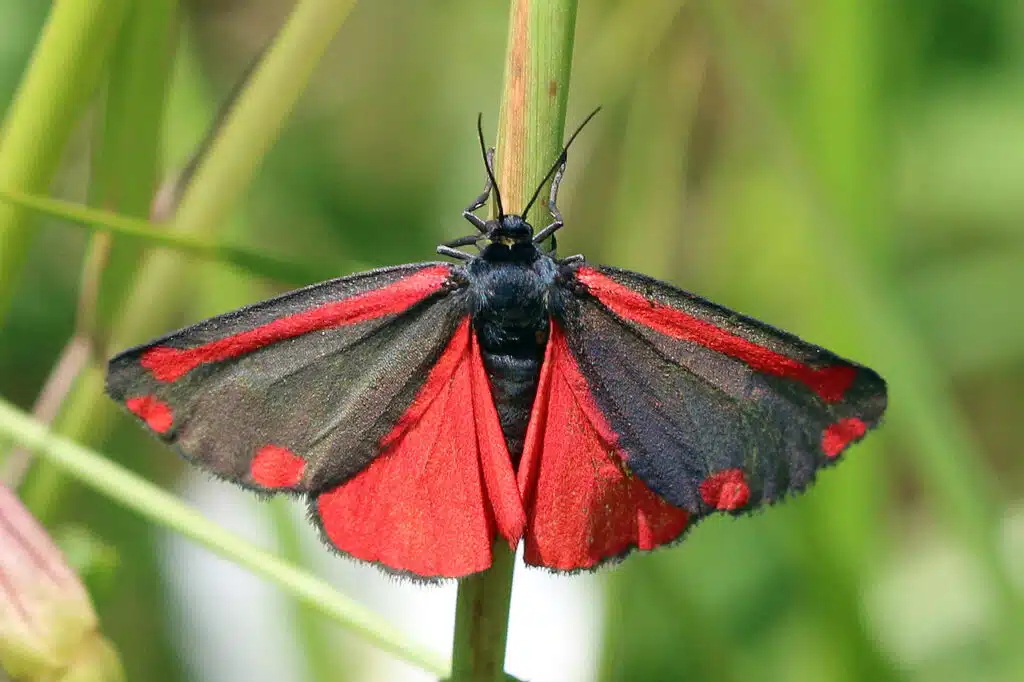
The species has black and red patches on both the forewings and the hindwings but in different percentages.
Its forewings are mostly black with some red coloring while its hindwings are mostly red. The body of the species is black.
This species is known to use ragworts and groundsels are host plants.
These host plants provide food for their caterpillars. Cinnabar moth caterpillars are known to be cannibalistic as well.
Caterpillars of the species turn cannibalistic whenever the host plant is overcrowded.
2. Cecropia Moth
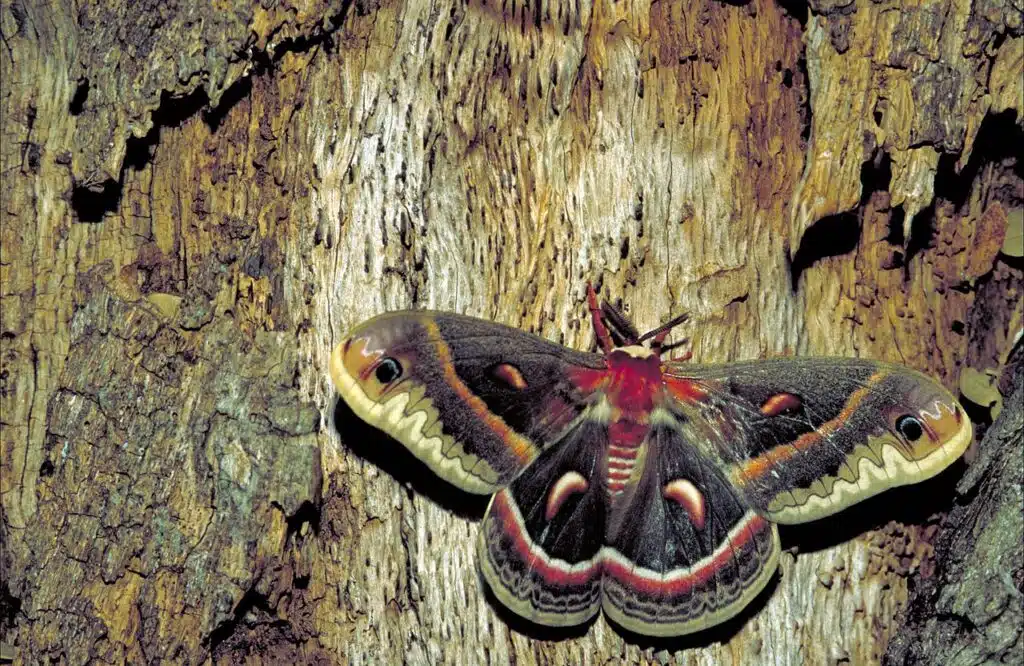
This species of moth (Hyalophora cecropia) has unique coloration which makes it a species common among collectors.
It has brown to gray wings with red and black lines across the lower part of the forewings and on the lower part of the hindwings.
Moths of this genus are further known for having black eyespots on the tips of their forewings and red coloration on the upper side of its head.
These moths are seen on at least 20 host species but aren’t considered a major pest since they move species frequently.
Native to Eastern parts of North America, this moth is known to travel by night with occasional stops to artificial light sources they are attracted to.
3. Squash Vine Borer Moth
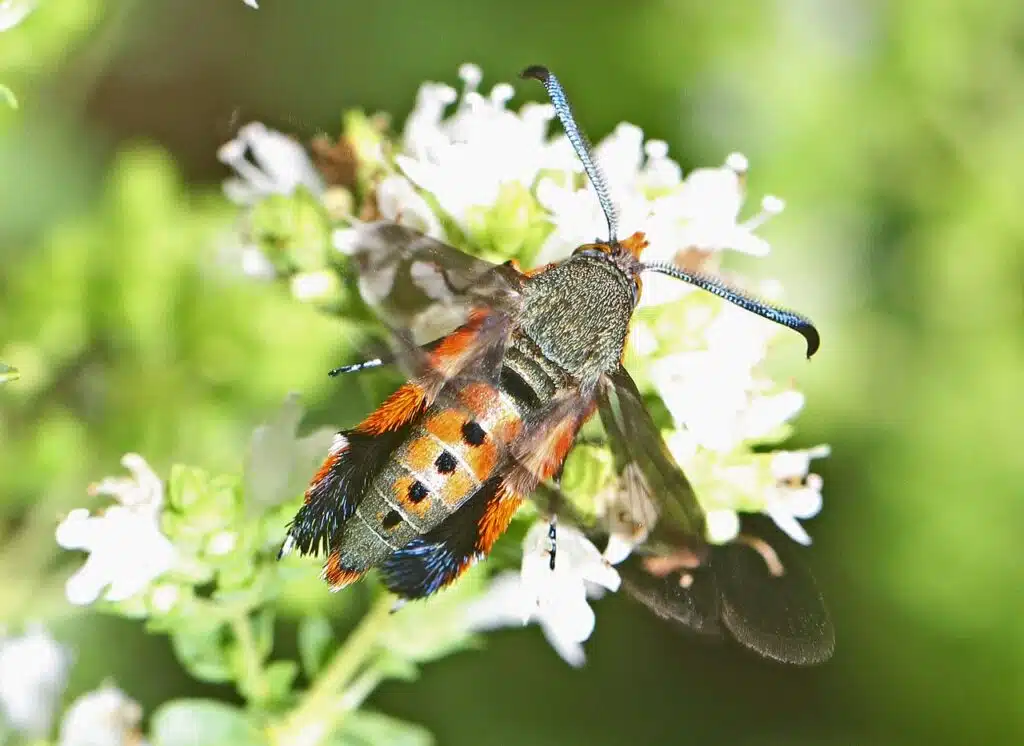
Squash Vine Borer moths (Melittia cucurbitae) are a colorful species that stand out with their large size.
The wingspan of these moths places them among the largest in North America. The species grows to a wingspan between 5 and 7 inches.
Male Squash Vine Borers are dominated by black, gray, brown, and red colorings while females are mostly red.
Males have red colors on the upper forewings and the lower hindwings.
Females have a red to brown color with various shades of gray overlays and black eyespots.
Black lines across the margins of the wings are also visible in females.
4. Western Sheep Moth
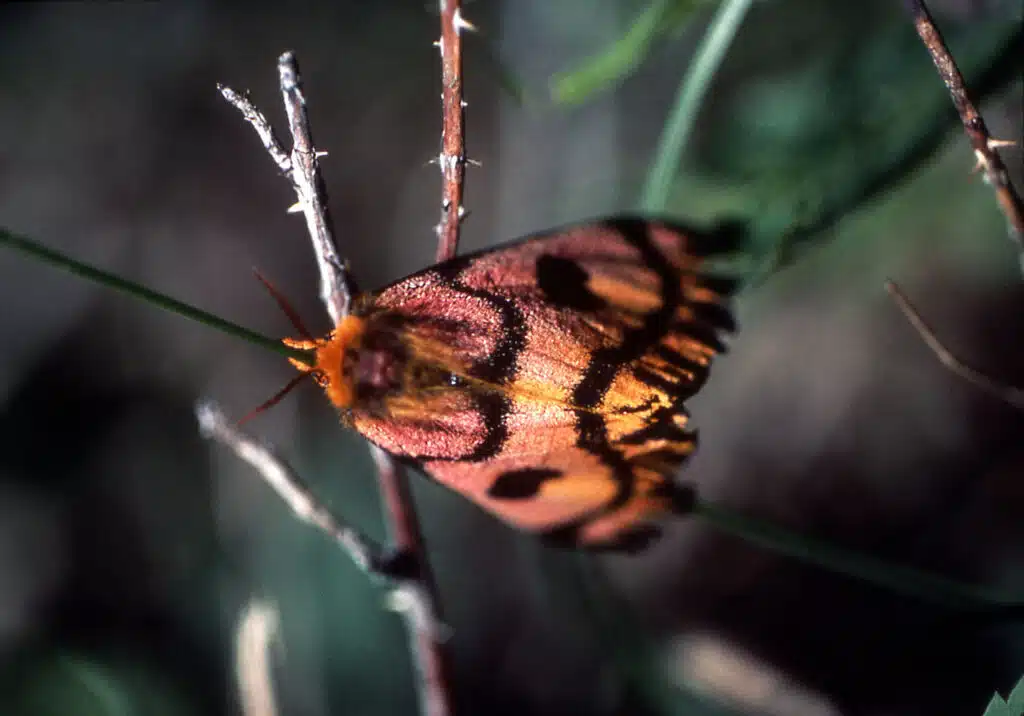
Western Sheep moths (Hemileuca eglanterina) have a medium to large size with a wingspan often longer than 3 inches.
These moths are seen in different states across the Western Coast, which inspires their name.
Western Sheep moths have colorful wings with show unique black eyespots and black stripes across the central and the marginal parts of the forewings and hindwings.
This species then shows gradient red to pink coloring from the upper forewings to the lower forewings.
A colorful nature is specific to the caterpillar of the species as well. The Western Sheep moth caterpillar has a purple to pink color and it feeds on mountain lilac at high elevations.
Adult moths of this species don’t feed at all.
5. Scarlet-winged Lichen Moth
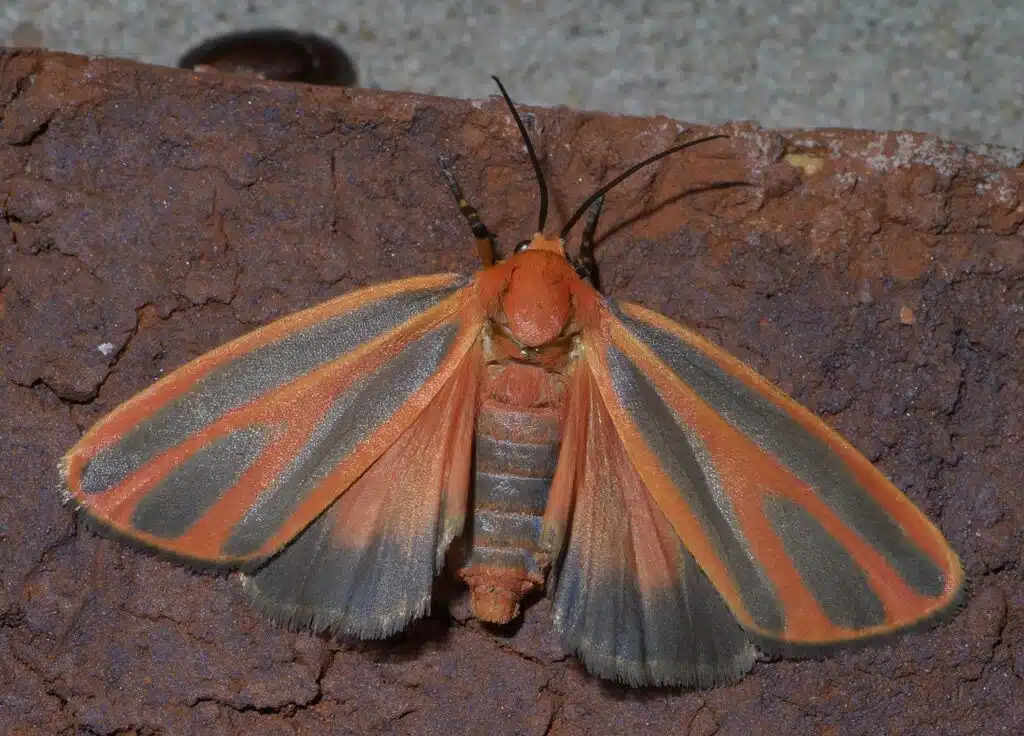
This species of moths (Hypoprepia miniata) are known for only showing red and black coloring.
Scarlet-winged Lichen moths eat lichens as adults. Preferred lichens include those on pine trees or other trees specific to high-elevation woodlands.
The wingspan of these moths is variable but it never measures more than 17mm.
You can identify this species by the red base color of the wings. Black vertical stripes are characteristic of this species.
Black and red color combinations are also specific to the legs and antennae of the species.
6. Spotted Oleander Moth
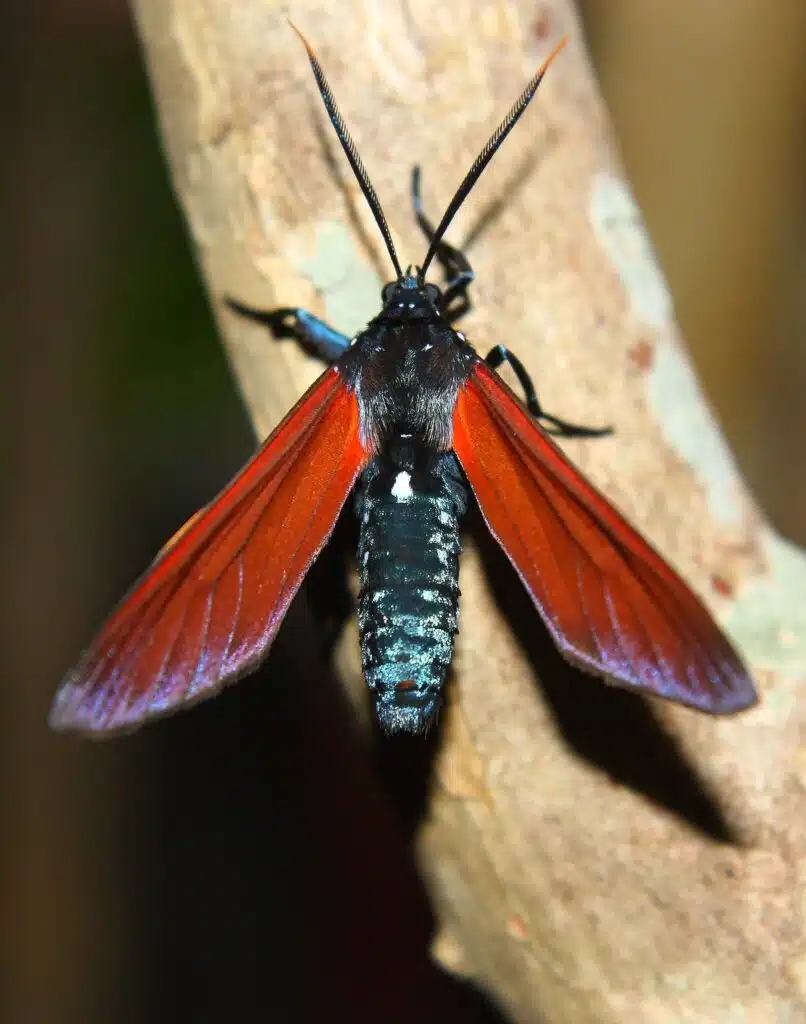
Spotted Oleander moths (Empyreuma pugione) are a species of black, red, and blue moths in Florida.
These moths aren’t a common sight in many other US states, but they have vivid coloring and a large size which makes them stand out.
Moths of this group can grow to a wingspan of just over 70mm.
The head and the body of the moth are black with blue nuances. Its wings are red, but not uniform red.
The vivid red coloring is specific to the upper side of the forewings. These colors turn to a gradient blue towards the lower side of the forewings.
Unlike other oleander moths, the Spotted Oleander moth isn’t a pest given it’s seen in low numbers every year.
7. Variable Reddish Pyrausta Moth
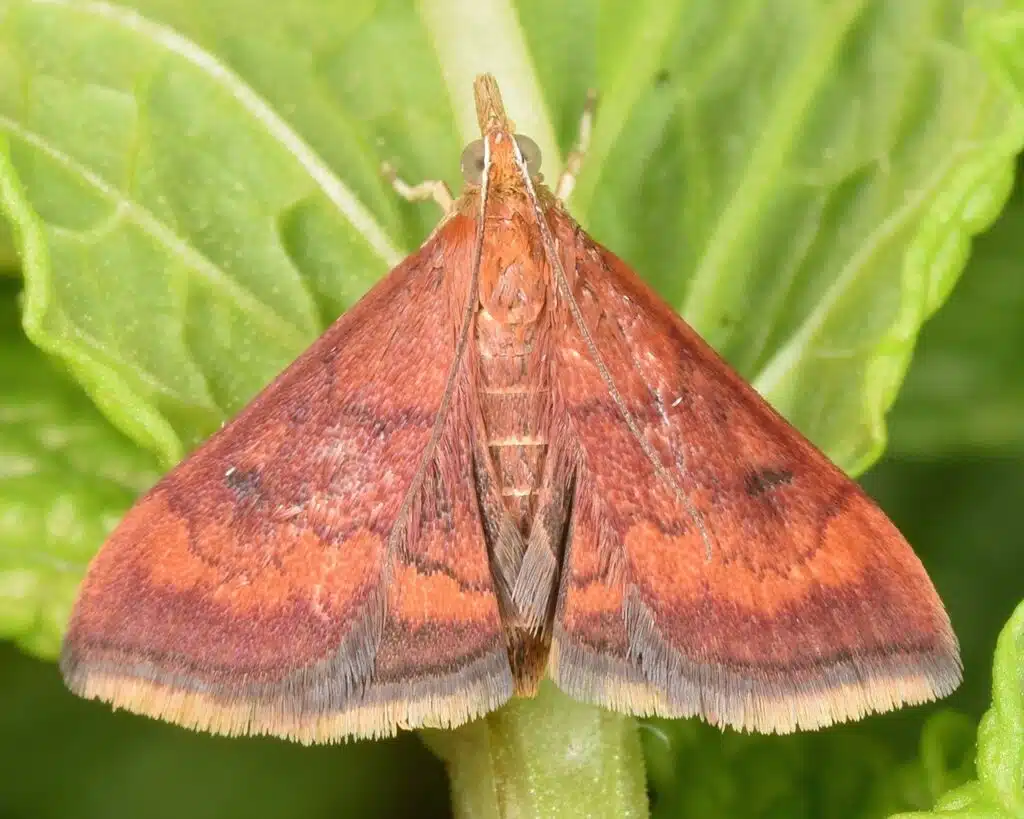
Variable Redditsh Purausta moths (Pyrausta rubricalis) have red and black coloring. The wings of the species are a combination of different shades of red with black margins and black patterns.
Common on white flowers, the moth has a short wingspan of up 15mm. You can see this moth on various white flowers across states such as Florida and Louisiana.
Unlike other moths seen on the Eastern Coast, the Variable Reddish Pyrausta moth has a presence on the Western Coast as well, albeit in lesser numbers.
This species of red and black moths are seen through the season since they have a long flight period. They appear in March and are still active until October. They overwinter soon afterward.
8. Joyful Virbia Moth
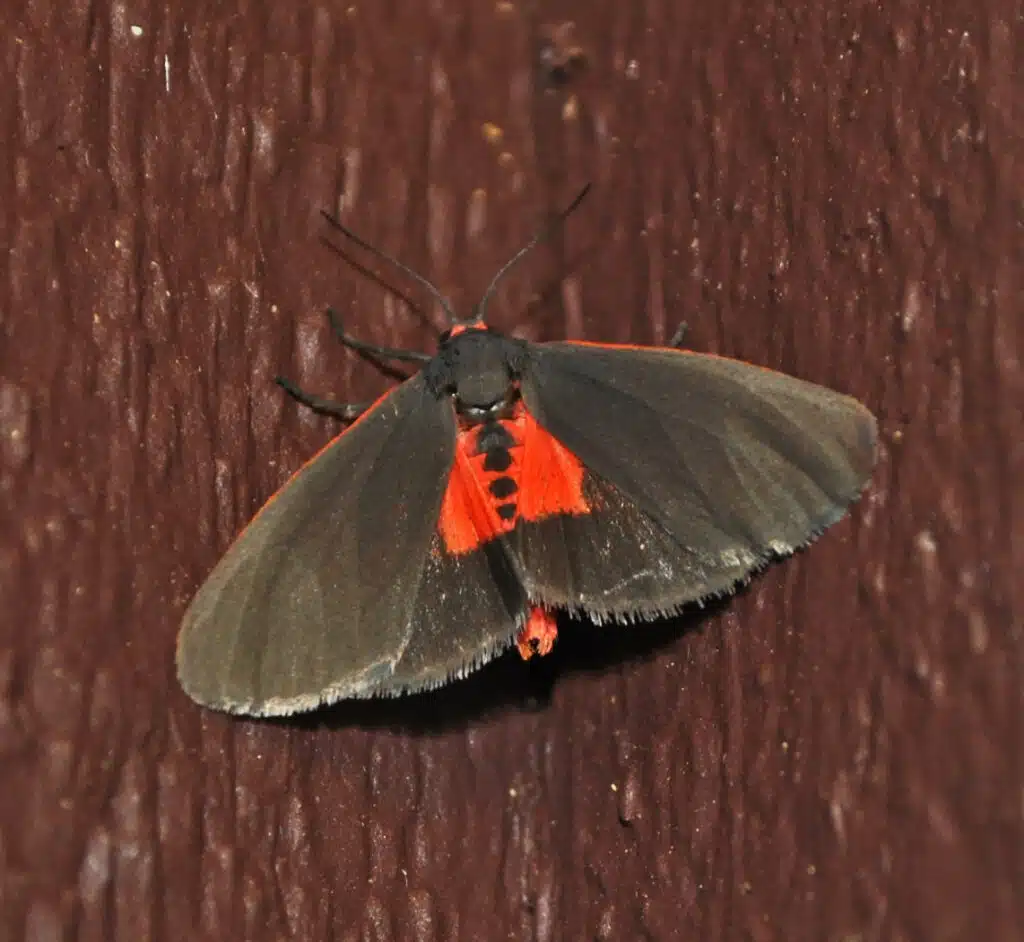
Joyful Virbia moths (Virbia laeta) have a base black color with red margins and red hindwings.
The upper forewings have a faint red margin while the rest of the wings are black. Its forewings are mostly red with a black lower side and black central dots.
2 tiny red dots are further visible on the back of its head.
These species have a long flight season in Southern states. It remains active throughout the year with December being the only month the species hibernates.
2 generations of Joyful Virbia moths are specific to Southern states while 1 generation is specific to Northern states.
9. White-tipped Ctenucha
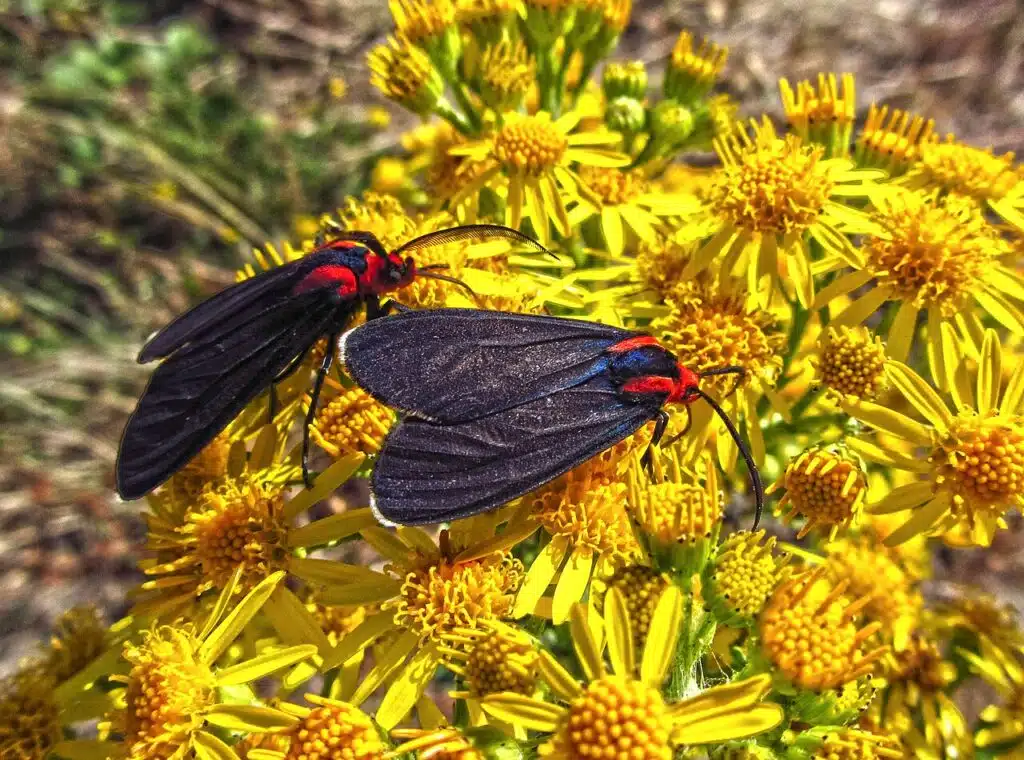
With a wingspan of up to 20mm, the White-tipped Ctenucha (Ctenucha rubroscapus) is a small moth species with a name inspired by the tips of its forewings.
This species of moths have black forewings and black hindwings. The margins of the forewings are white while red coloring is specific to the upper side of the forewings and the head.
Some morphs of this species have orange coloring instead of red coloring in the area of the head.
Coastal areas in North America are preferred by this moth species.
Adapted to warm climates, this moth is still only present in these habitats for a short time until September.
10. Grapeleaf Skeletonizer Moth
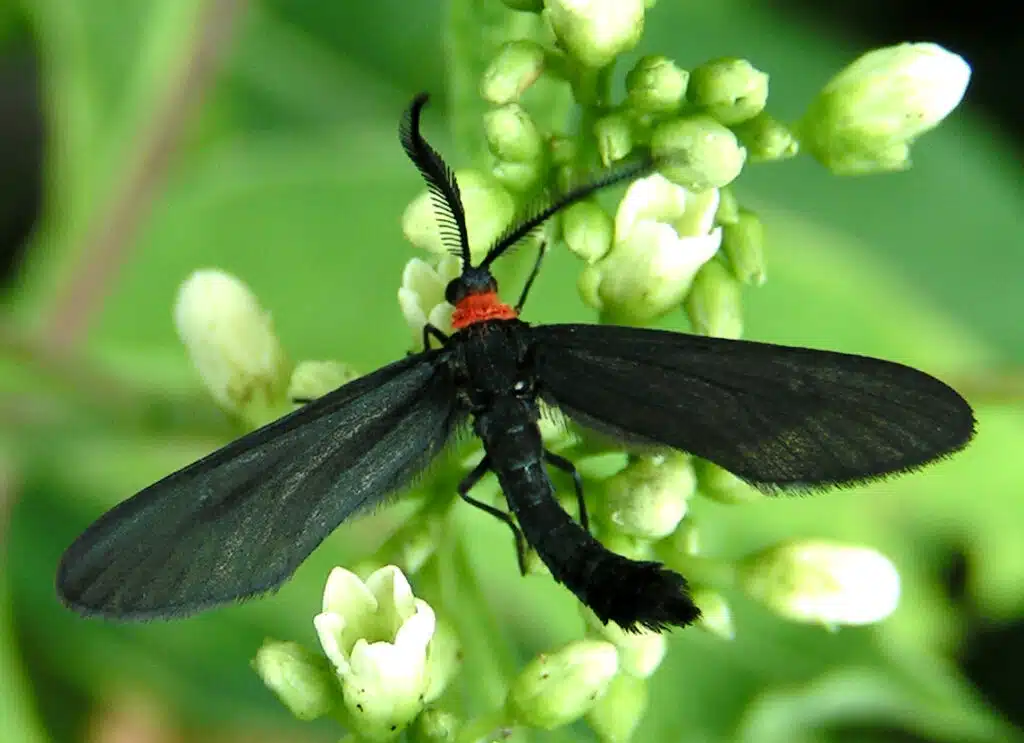
Grapeleaf Skeletonizer moth (Harrisina americana) gets its name from its grapevine host. This moth is known to attack the leaves of grapevines that it eats.
Skeletonization is specific to the leaves of the species which eats entire leaves apart from their veins.
Moths of this species are further known for their impact on grapevines in Florida.
However, this moth isn’t seen as a major pest as it’s kept under control with typical pest-control measures.
The species is almost completely black. Adult moths have black wings with black bodies and an orange or red ring around the neck.
Moths of this genus grow to a maximum wingspan of up to 28mm.
11. Southwestern Squash Vine Borer
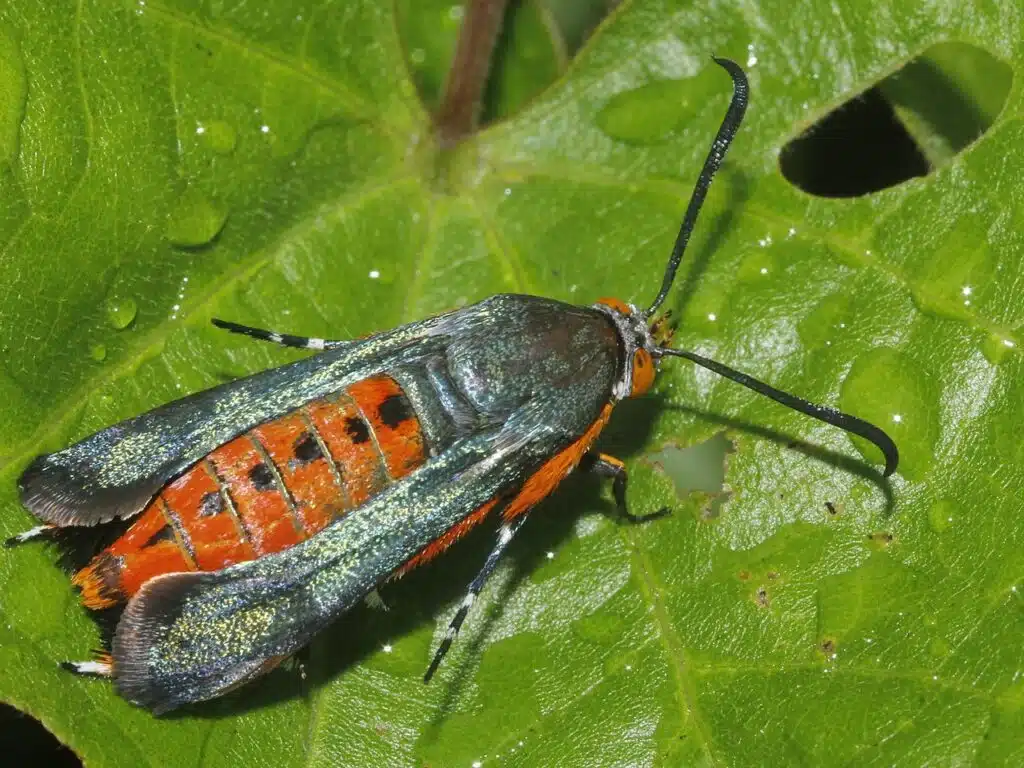
The black and red Southwestern Squash Vine Borer (Melittia calabaza) is a species that looks similar to wasps.
While colorful, this species is one of the most troublesome pests for squash. Native to Southwestern US territories, the vine borer is commonly found in gardens.
You can identify this species by its mostly black body with black wings and a central red section. Tiny black dots are also seen on the central red section of the species.
Southern Squash Vine Borers feed on almost all parts of squash.
The biggest issue about this species is that it lays eggs that grow as larvae inside stems. They often get overlooked as a result.
12. Kermes Scale Moth
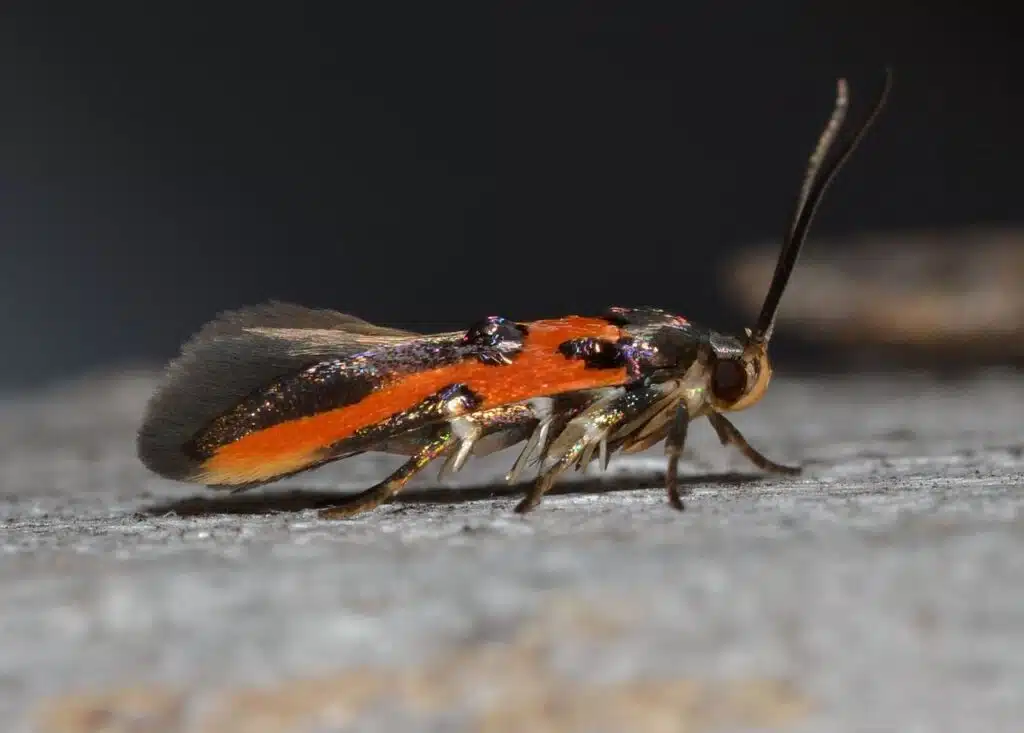
This black and red moth (Euclemensia bassettella) also looks similar to a wasp. The species is native both to Canada and the US with a wide distribution around oak woodlands.
Kermes Scale moths aren’t easily seen, however. They are only seen on oak trees infected with pests.
Scale insects are among the most common species that nest in oaks. These are also the insects that interested Kermes Scale moths.
Most of these moths eat these insects.
Known for a short wingspan of up to 14mm, these moths fly up on trees to find scale insects and their eggs they feed on.
13. Scarlet-bodied Wasp Moth
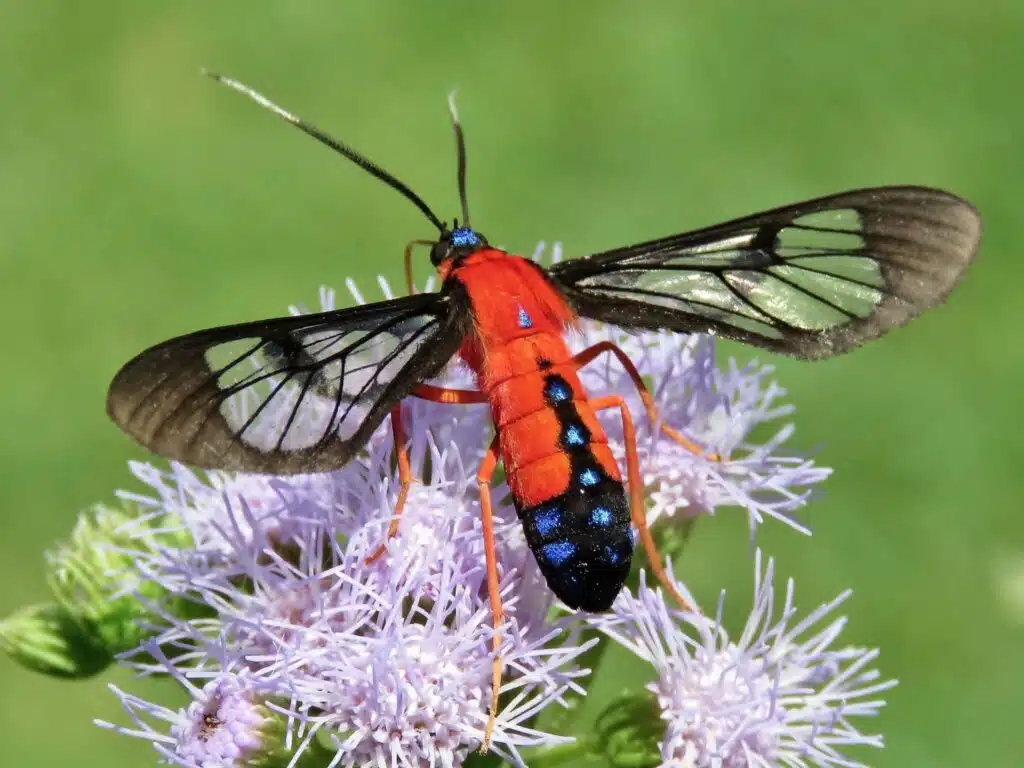
Scarlet-bodies Wasp moths (Cosmosoma myrodora) are a species of black and red wasps that have almost fully transparent wings.
This species only has black visible veins while the rest of the wings are transparent. These types of transparent wings mainly improve camouflage.
Red is the main color of the body while the head and the antennae of this moth are black.
Dog fennels are the primary food source for these moths. Adults are capable of extracting the toxic compounds in these plants which are used to give them a protective bad taste.
14. Black-winged Dahana Moth
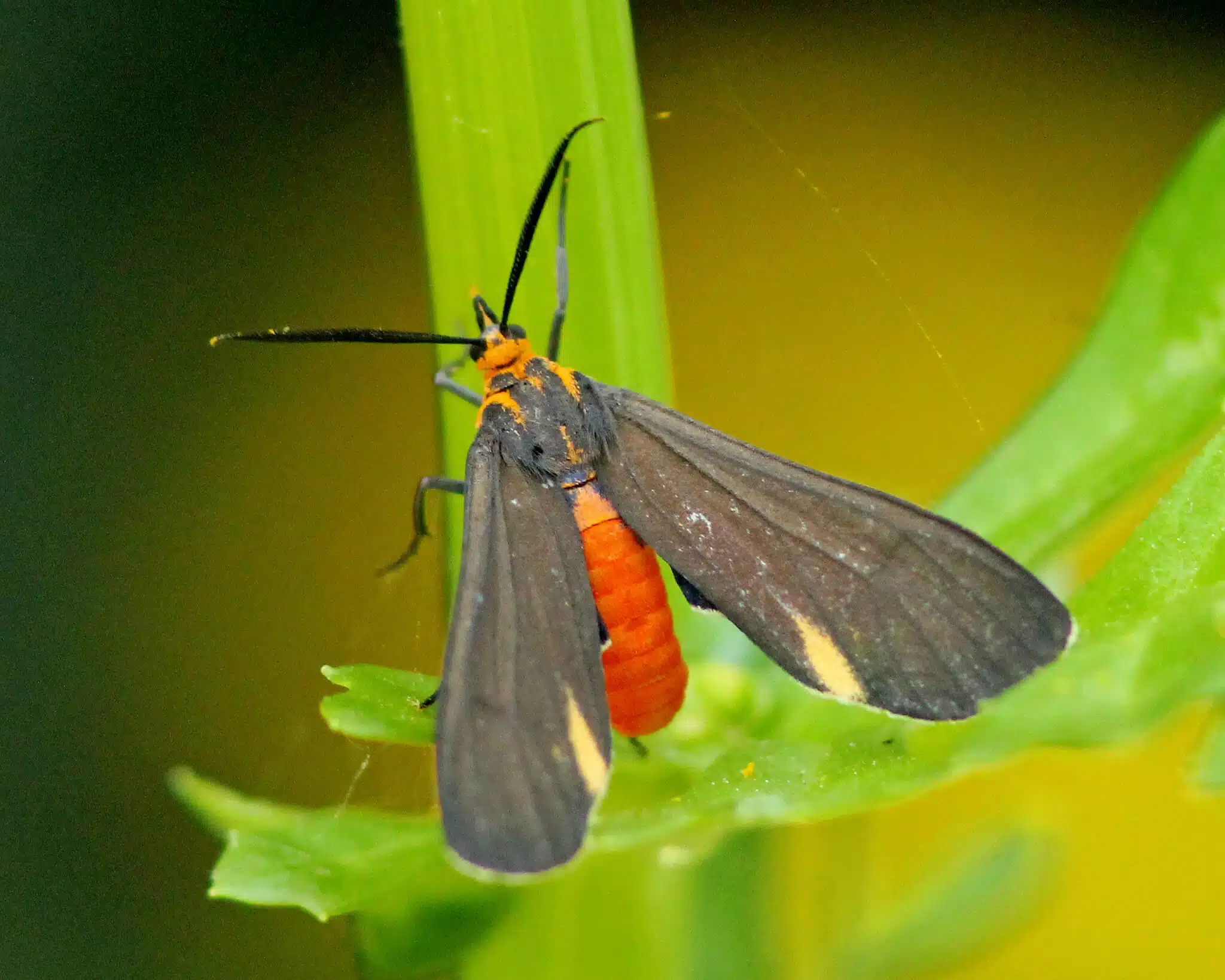
Only found in Florida and Georgia, the Black-winged Dahana moth (Dahana atripennis) bears some resemblance to the Scarlet-bodies Wasp moth.
Both species have a red body but the Black-winged Dahana moth has a wider upper black section of the body.
This moth also has fully black wings.
Tan to brown marks is sometimes seen on the margins of the wings of the Black-winged Dahana moth.
15. Yellow-banded Wasp Moth
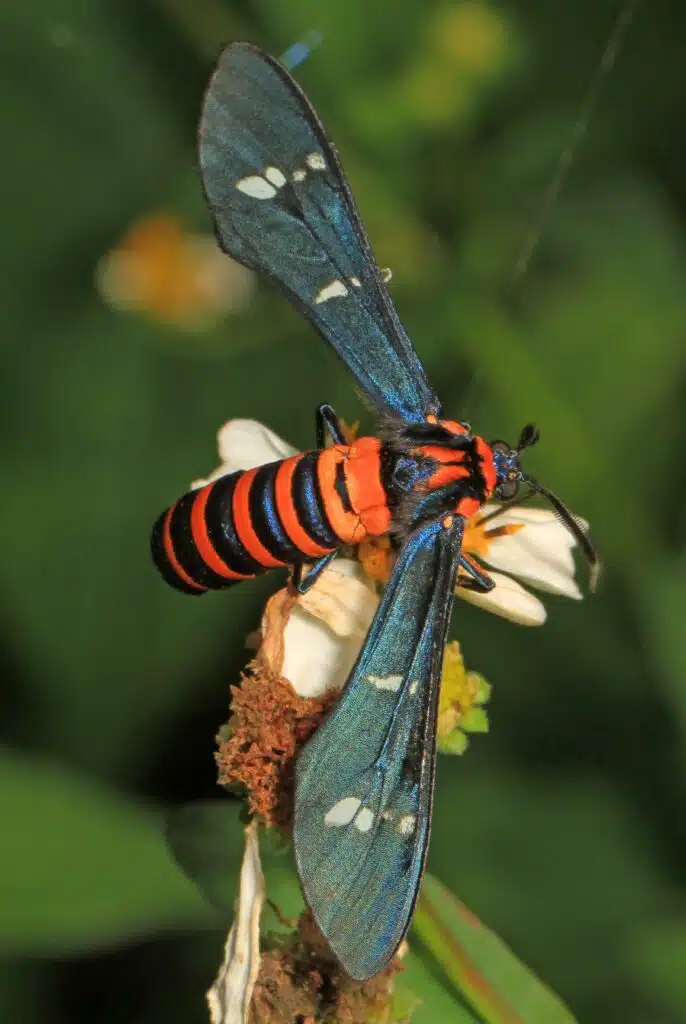
Yellow-banded Wasp moths (Syntomeida ipomoeae) are a species of moths that mimic wasps in their looks.
Larger than a typical wasp, this moth species comes in either orange and black or red and black coloring.
Its body is mostly red with black bands on the lower body.
The wings of the species are black with small white dots.
Antennae and legs are always black both in the red and black and in the orange and black morphs of the species.
16. Electra Buckmoth
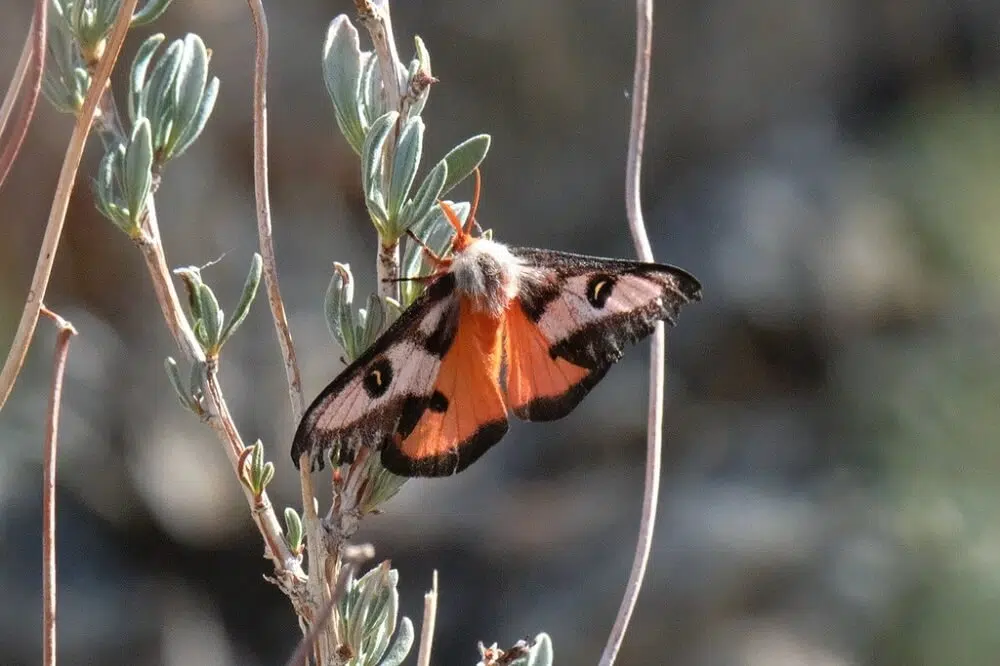
Electra Buckmoths (Hemileuca electra) are native to California, Nevada, and Arizona.
This species has black, white, and red colors.
Its forewings are white with black margins and black eyespots. The hindwings of this species are red.
Its hindwings aren’t visible when in a resting position as the forewings cover the red sections.
You can find the species on flat top buckwheat starting from September.
This species has a short lifespan and adults don’t feed.
Electra Buckmoths are only active until November, mainly in coastal regions of California.
17. Ruby Tiger Moth
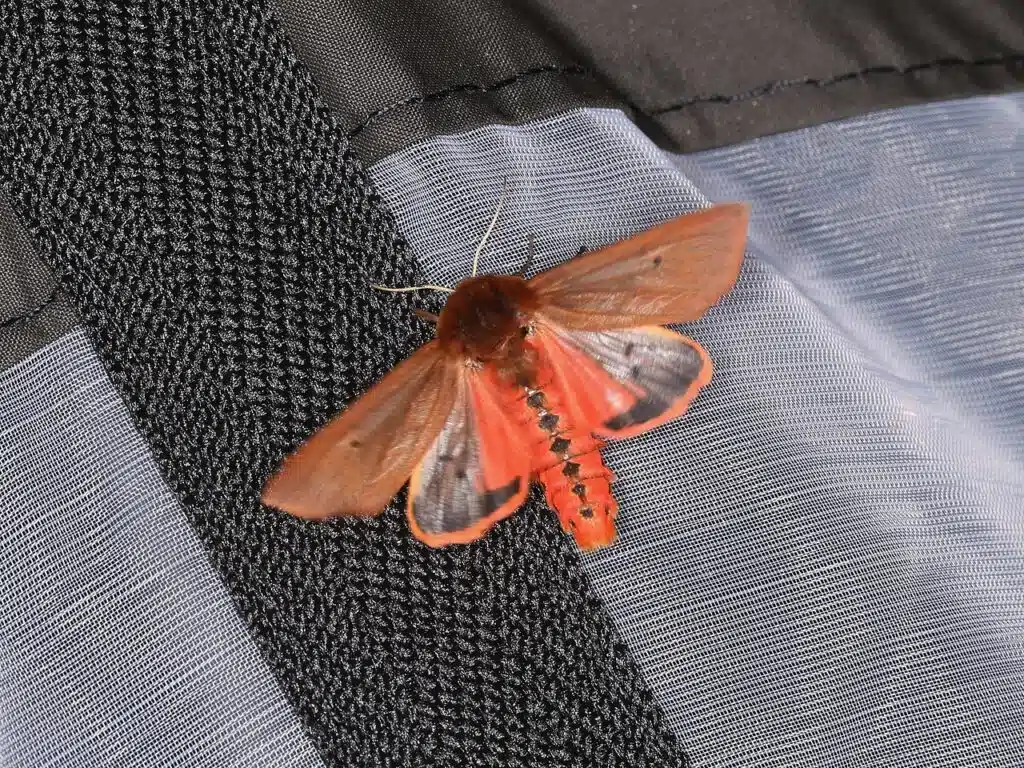
Ruby Tiger moths (Phragmatobia fuliginosa) are a species with a red-brown color that even lays red eggs.
This moth has red to brown wings which can sometimes be rusty red. The body of the species exhibits alternating black and red bands.
Moths of this family are further differentiated by the hairy head and upper body. Short red hairs are distinguished in this area.
18. Six-spot Burnet
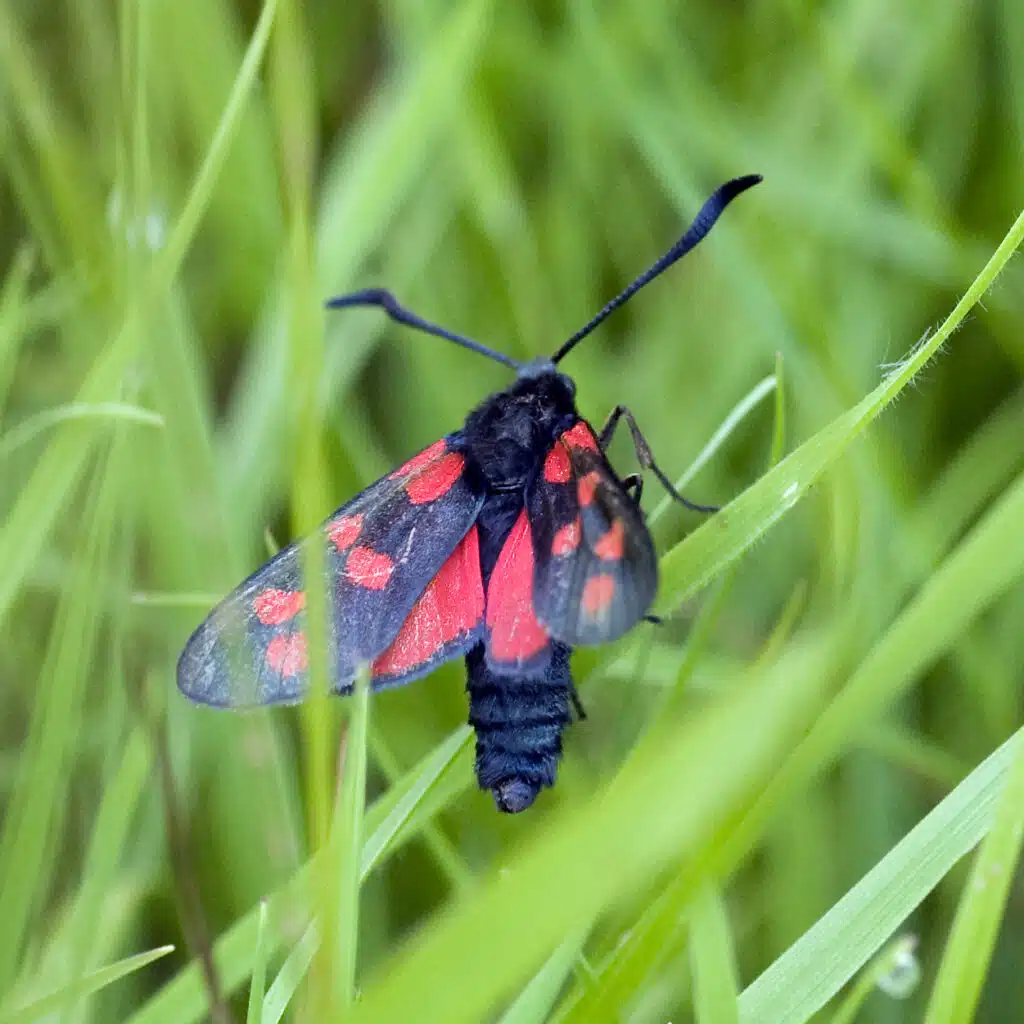
Common in North America, the Six-spot Burnet (Zygaena filipendulae) is found in open areas, meadows, and woodlands.
This species is named after the number of red spots visible on its wings. The base color of the wings is black and its body is also black.
6 red spots are visible on each wing.
Six-spot Burnets have a wingspan of up to 40mm. This species is known to only feed on knapweed.
19. Narrow-bordered Five-spot Burnet
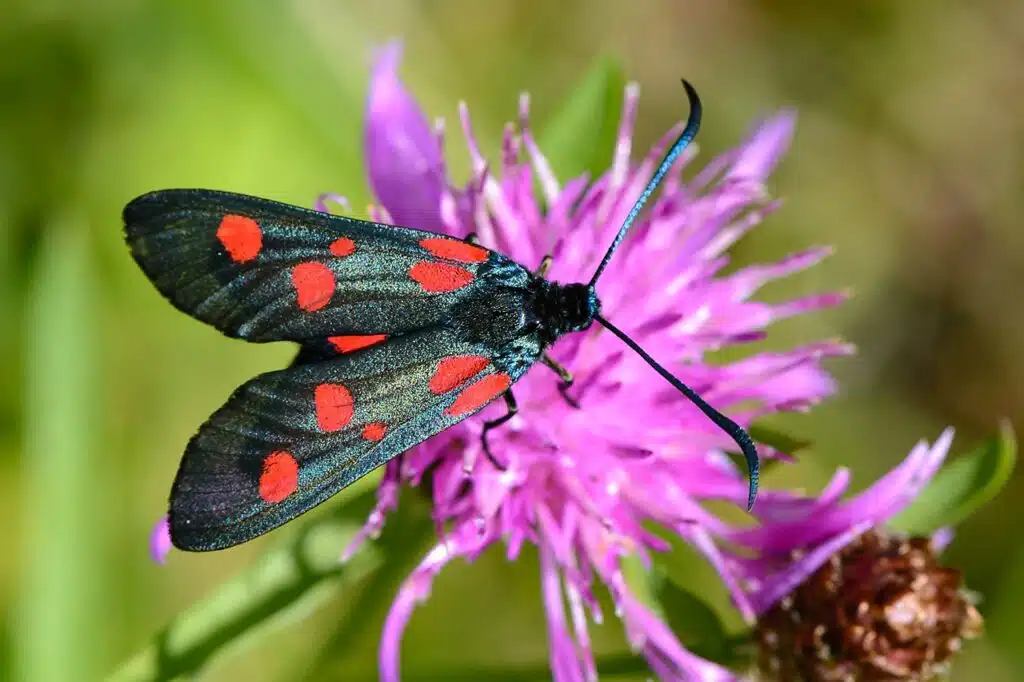
Narrow-bordered Five-spot Burnets (Zygaena lonicerae) have black and red coloring of the wings and a black body.
This species is common in multiple US states where it can find thistle and knapweed for nectar.
This species is identified by its small to medium body with a wingspan between 30 and 38mm.
Its forewings are black with different-size red spots. Its hindwings are mostly red with black margins.
Different morphs of the species are rare. Most look similar but have yellow color on a black base instead of red spots and wings.